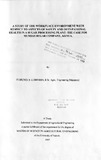| dc.description.abstract | A study was undertaken at Mumias Sugar Company to establish the status of the
workplace environment with respect to some aspects of Safety and Occupational health in
a Sugar Processing Plant between December, 1996 and March, 1997.
Studies were conducted on the environmental aspect of Hot working environments in the
factory and the Dust manifestation from bagasse handling. Measurements of the
environmental components were done to establish the thermal balance associated with the
working environment in the Process house and Boiler house. Dust samples were taken to
establish the dust concentration associated with the various workplaces. In the analysis,
the least significant difference criterion was used to compare the observed means of
established parameters. A questionnaire survey was conducted to establish the
psychological consequences of the working environment on the exposed personnel and to
facilitate a quantitative access to the people's subjective judgment of their working
environment.
The thermal loads in the Process house were found to be significantly different, at 5%
level of significance, attributed to the poor ventilation and uncontrolled sources of thermal
stress, thus implying higher thermal stress among the exposed personnel than in the boiler
house where the thermal loads were not significantly different. Dust concentrations were
not significantly different, but the dust level III the bagasse store exceeded the
recommended exposure limit.
The results of the study indicated a need for better ventilation, provision of thermal
clothing, or limiting exposure to these uncontrolled thermal stress conditions through the
introduction of new working schedules for hot working environment, while special storage
designs, alternative delivery means, or the application of moisture during the disposal of
bagasse, to prevent the bagassilo from becoming airborne, were found necessary.
The results of the research will form the basis of a qualitative and quantitative assessment
of some of the risks involved in a sugar processing industry which is a major requirement
for the planning and effecting a health and safety programme in any industry. | en |

